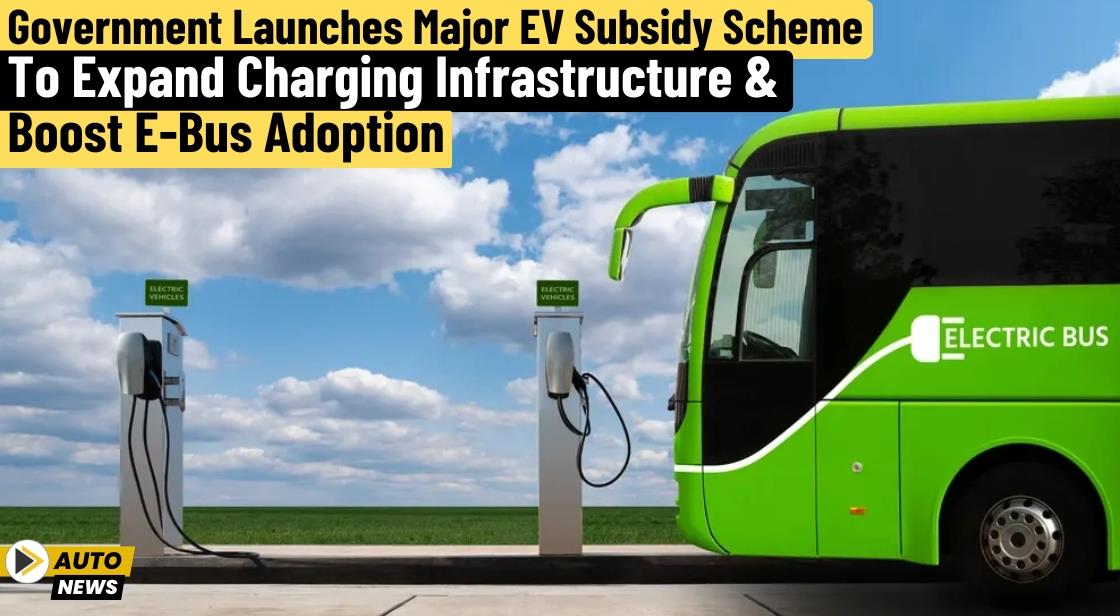Government Launches Major EV Subsidy Scheme to Expand Charging Infrastructure and Boost E-Bus Adoption

News Synopsis
The Indian government has unveiled a landmark ₹10,900 crore electric vehicle (EV) subsidy scheme, titled PM E-Drive, aimed at accelerating the adoption of electric buses (e-buses) and bolstering India's electric mobility infrastructure. The scheme marks the third phase of the Faster Adoption and Manufacturing of Hybrid and Electric Vehicles (FAME) initiative, which since 2015, has subsidized over 1.6 million electric vehicles in the country.
Govt launches ₹10,900 cr EV subsidy scheme
This ambitious new scheme primarily targets e-buses, while subsidies for electric and hybrid cars have been discontinued. As part of the PM E-Drive initiative, demand incentives will be provided for the deployment of 14,028 electric buses, with the aggregated demand coming from nine major cities. The Convergence Energy Solutions Ltd (CESL), a state-run company, will manage the aggregation. The initiative is set to revolutionize India's public transportation by encouraging e-bus adoption on a large scale.
Subsidies and Allocations for Electric Buses and Other Vehicles
The government's focus is squarely on public transport, with a ₹10,000 subsidy per kWh of battery capacity for each electric bus, totaling ₹4,391 crore. E-buses form the largest segment of the subsidy allocation, reflecting the government's commitment to greening India’s public transportation system.
In addition to electric buses, the scheme allocates ₹2,679 crore to subsidize 2.48 million electric two-wheelers and 316,000 electric three-wheelers, further driving the transition to cleaner and more sustainable transport options across the nation. The government is also focusing on critical services and commercial vehicles by earmarking ₹500 crore each for electric trucks and hybrid ambulances.
"For ambulances, we are going to give incentives to hybrids because we need total reliability in the vehicles," said Ashwani Vaishnav, Union Minister for Information and Broadcasting, during a Cabinet briefing. To ensure sustainability, only trucks with a scrapping certificate from an approved vehicle scrapping center can avail the incentives.
Electric Car Subsidies Excluded in the New Scheme
Notably, the PM E-Drive scheme does not provide subsidies for electric cars, a disappointment for automakers like Tata Motors Ltd, India’s largest electric car manufacturer, which had lobbied for the inclusion of electric cabs in the new policy. Under FAME-II, electric cabs were given subsidies, but the Electric Mobility Promotion Scheme (EMPS), which temporarily replaced it, did not extend these incentives. The exclusion of electric cars from the PM E-Drive scheme indicates a shift in government priorities towards public transportation and commercial EV adoption.
Development of Charging Infrastructure
The scheme also takes significant steps toward expanding India’s EV charging infrastructure. A whopping ₹2,000 crore has been allocated for the installation of fast chargers across key cities with high EV penetration. This includes 22,100 fast chargers for electric four-wheelers, 1,800 fast chargers for e-buses, and 48,400 fast chargers for two-wheelers and three-wheelers. This development is essential to foster a more robust and reliable EV ecosystem, supporting the growing number of EV users across the country.
Payment Security Mechanism Fund for E-Buses
To further promote the adoption of electric buses, the government has introduced a Payment Security Mechanism Fund (PSMF) of ₹3,435 crore, aimed at mitigating financial risks for bus operators. This fund will cover 38,000 electric buses and is expected to significantly enhance the confidence of bus operators, facilitating the shift towards an electrified public transport network.
Digital Vouchers for EV Buyers
The government has also introduced a digital innovation in the form of e-vouchers to streamline the process for buyers availing subsidies. "MHI is introducing e-vouchers for EV buyers to avail demand incentives under the scheme," the Ministry of Heavy Industries (MHI) stated. The e-voucher will be Aadhaar authenticated and sent to the buyer’s registered mobile number. The buyer can then submit the signed e-voucher to the dealer, who will upload it on the PM E-Drive portal for the original equipment manufacturer (OEM) to claim the subsidy. This process ensures transparency and efficiency in disbursing incentives.
"This forward-thinking initiative reflects the government's unwavering support for India's transition to electric mobility, fostering innovation and investment within the sector," said Shailesh Chandra, president of SIAM, emphasizing the scheme's potential to propel India’s leadership in the global EV movement and boost environmental sustainability.









